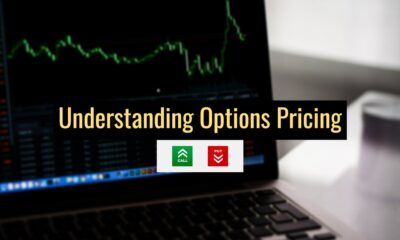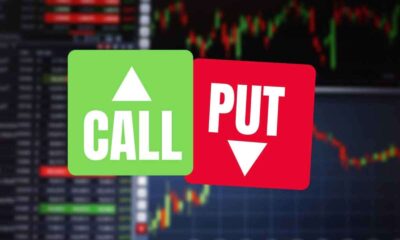Option Trading
Option Trading FAQs
Published
2 years agoon
By
Ajit Singh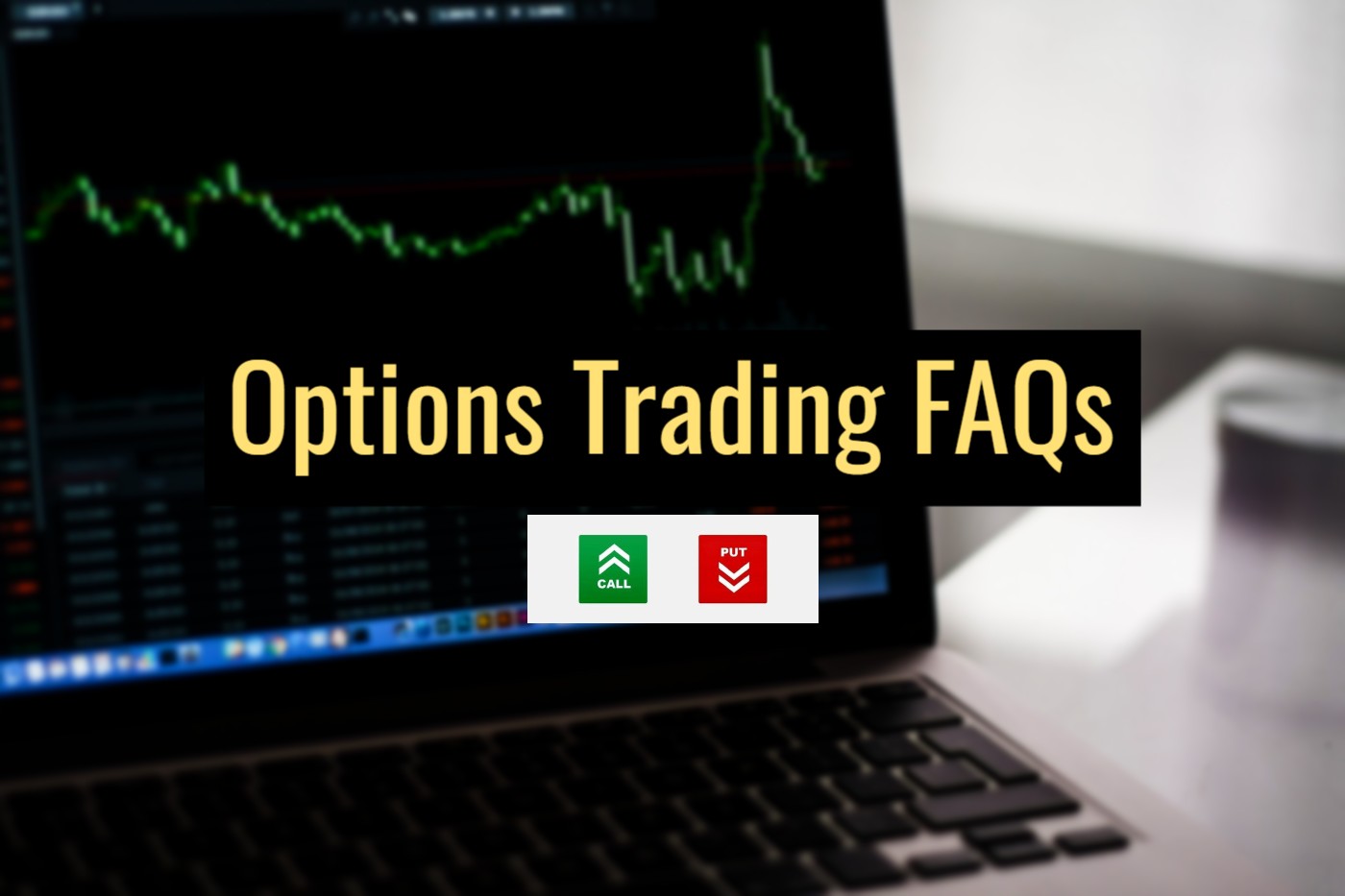
Options Trading Basics FAQ provide answers to commonly asked questions about Options Trading Basics FAQ in Indian Stock Market. This Options Trading Basics FAQ list is to help investors for their better understanding of Options Trading Basics FAQ and to resolve their quires.
We welcome you for your comments to improve answers of the questions asked in this category. Please feel free to post comments. We appreciate your participation in building this page simple, easy to understand, relevant and correct information provider to the Indian Investor Community.
1. How do options work?
Options are derivatives of an underlying financial instrument like stocks, commodities, and currencies. A good analogy is the curd which is a derivative of milk. So, just like increase or decrease in the price of milk increases or decreases the price of curd, similarly, movements in prices of the underlying instrument affect the price of options.
Options are traded in exchanges MSE, MCX etc., like stocks and commodities. Every option contract mentions its strike price, premium, lot size and expiry date.
Strike price: The price at which the buyer and the seller of an option have agreed to enter the option contract.
Premium: The payment made by the buyer to the seller to earn his right to an option contract.
Expiration day: The last day that the option owner can exercise the right.
Lot Size: The fixed number of units of the underlying instrument that form part of a single Options contract.
Like any other business transaction, options trading includes buyers and sellers. The buyers of options have rights or a choice and sellers have obligations. The buyers have the choice to exercise his right to buy/sell option before expiry or else opt out and allow the option to expire.
Options are of two types: calls and puts. A Call option gives you the right to buy the option whereas a Put option gives you the right to sell the option.
There is no delivery of options. All transactions are settled in cash.
2. What are the different types of options?
Options are of two types – Call Options and Put Options
- Call Options give you the right, but not the obligation, to buy an option contract.
- Put Options give you the right, but not the obligation, to sell an option contract.
Example of a Call Option:
You buy a call option on TCS for October at the strike price Rs 2000 at a premium of Rs 200 for a lot size of 100 shares. This gives you the right to buy 100 shares of TCS at Rs 2000 anytime from now until the end of October. To earn this right, you pay a premium of 100 X Rs 200 shares= Rs 20,000. Now, if the price of the option at any time before expiry is higher than Rs 2100, then you may exercise the options and earn profits. Say the option price is Rs 2150. You will get-
Rs 150 (Strike Price- Market Price) X 200 shares= Rs 30,000.
Your profits will be Rs 30,000 – Rs 20,000 = Rs 10,000.
In case, your option didn’t do well in that period and remained below Rs 2000 then you can choose to opt out. In that case, you will only lose the premium amount of Rs 20,000.
Example of a Put Option:
You buy a Put option on TCS at the strike price of Rs 2000, at a premium of Rs 100 for a lot size of 100 shares. You pay a premium of Rs 100 X 100 = Rs 10000 while buying the option. If the Price of TCS option remains below, then you will earn profits by selling the option. However, if the stock price remains higher than strike price then you could choose not to exercise the right and will only lose the premium.
3. What is the strike price of an option?
Strike price, also called as purchase price, is the price at which the underlying instrument of a particular option can be purchased. For a call option, it is the price at which the underlying instrument can be bought, while for a put option, it is the price at which the underlying instrument can be sold.
The Strike price is different from the price at which the option is purchased and is fixed.
4. What is the Expiration Day of Options?
Every Option has an expiration day or date. You can exercise your right to buy/sell till this date. The expiration date is the last Thursday of the month. In case of a holiday, the contract expires on the previous trading day. So, all April 2018 contracts have the expiration date of April 26, 2018.
5. How do I trade options?
Options contracts can be traded through broking firms who are members of NSE and BSE. Most of the trading members these days provide online and mobile trading platforms to trade in the options market. You need to open an account with one of the broking firms and complete the formalities like application signup, KYC etc. Please make sure that the broking firm you’re opening your account with facilitates trading in options as there are firms who either don’t allow options trading or allow only some types of options trading like equity options but not commodity and currency options.
You will be allocated a client id, password to login to the online, web and mobile platforms. You also need to maintain a margin amount and bank account will be linked to your trading account to facilitate the transfer of funds. The firm will also open a demat account.
Trading in options is as simple as trading in shares-
- Login to the website and application.
- Click on the place order tab.
- Search for and select the desired Option.
- Enter details like exchange, expiry date, lot size, order type etc., and place order.
- Congratulations, your order is placed.
6. What is the difference between futures and options?
- Futures and Options are types of derivatives. Derivatives derive their value from an underlying instrument like a stock, commodity, currency etc. The basic difference between Futures and Options is in the obligations bound on the buyers and sellers.
- In Futures, both, buyers and sellers have an obligation to execute the contract on a specified date whereas in Options, the buyer has the right but not the obligation to execute the contract. Only the seller has the obligation to execute the contract.
- The other difference between Futures and Options is in the limit of profit and loss for a buyer. A buyer in Futures market can make unlimited profit and loss. In the Options market, a buyer can make an unlimited profit but limited loss.
7. How is Nifty traded?
Nifty is traded the same way as any other Option. Nifty is an Index Option. An Index is a collection of stocks such as Nifty 50, NSE Bank Nifty or NSE Nifty Midcap 50 etc. A Nifty Option is derived from the underlying Nifty. So you have Options for Nifty 50, NSE Bank Nifty or NSE Nifty Midcap 50 etc. Each of these Options has their own strike price, premiums, lot sizes, and expiry dates.
8. What happens if an option expires out of the money?
There can be two scenarios:
- When Call Option expires out of the money
- When Put Option expires out of the money
When a Call Option expires out of the money: A call option is said to be Out of The Money (OTM) if the strike price is higher than the current market price of the underlying instrument. In such a case, the buyer loses the premium paid to buy the contract and the seller earns the profit.
When a Put Option expires out of the money: A put option is said to be Out of The Money (OTM) if the strike price is lesser than the current market price of the underlying security. In such a case, the buyer loses the premium paid to buy the contract and the seller earns the profit.
9. Is there any Margin payable in Options?
When you buy an Options contract, you don’t need to pay a margin as your loss is limited. You need to pay a premium amount. Your loss will be limited to the value of premium.
When you sell an Options contract, you need to pay a margin requirement as there is a chance of unlimited loss and limited profit. So you need to maintain the margin amount as decided by the exchange.
10. How are the Options contracts settled?
All Options contracts are settled in cash on a daily basis and on the expiration date. Traders are not required to hold any stocks.
11. What are Covered Options?
When a trader sells an Option and at the same time holds the underlying instrument, it is called Covered Options. For example, A trader sells SBI Option Reliance and at the same time holds shares of SBI so as to deliver the shares in case the buyer exercises the right.
12. What are Naked Options?
When a trader sells an Option but doesn’t hold the underlying instrument, it is called Naked Options.
13. What is an American Option?
An American Option is an option contracts that can be exercised i.e. bought or sold at any time until the expiry date. Options on individual companies like Reliance, SBI etc., are American options.
14. What is an European Option?
An European option is an option contract that can only be exercised on its expiry date. All index options are European type of Options.
15. What is In-The-Money (ITM), At-the-money-option (ATM) and Out-of-the-money-option (OTM) in Options?
- When the current price of a Call Option stands is higher than the strike price it is said to be In-The-Money (ITM). For a Put Option, when the current price is lower than the strike price then it is said to be In-The-Money (ITM).
- When the current price of option equals to the strike price, then the option is said to be At-The-Money.
- When the current price of a Call Option stands is lower than the strike price it is said to be in Out- of-The-Money (OTM). For a Put Option, when the current price is higher than the strike price then it is said to be Out-of-The-Money (OTM).
16. How to decide on whether should I buy or sell Call or Put options?
Your decision to buy/sell call or put options should depend on the your market outlook. If you think that the market will do well this month then you should consider ‘BUY Call Option’ or ‘SELL Put Option’. If you think that the market will fall this month then ‘SELL Put Option’ and ‘BUY call Option’ would be the right move.
17. Can I trade on options of any stock or Index?
No, you cannot trade on options of any stock or Index. Exchanges select companies and Indexes whose Options can be traded on. From time to time, Options of new companies or Indexes are allowed to trade.
18. What is the difference between square off and exercise an Option?
When you take exactly opposite of your existing position, it is called squaring off.
Let’s say, your existing position is BUY Call Option on Reliance. Now if you SELL Put Option on Reliance with same strike price, lot size and expiry then you’re squaring off your position.
You exercise an Option, when you want to take delivery of the underlying stocks, commodities or currency of the Option.
19.What is intrinsic value of the option? How to calculate intrinsic value of an option?
Intrinsic value of an Option is the amount by which the strike price of an option is in-the-money. It is also considered as the value of an Option if it were exercised today.
For Call option
- Intrinsic value = Current price of underlying – Strike Price
For Put Option
- Intrinsic value = Strike Price – Current price of underlying
For example, you hold a Reliance Call Option at 900 and the current price of the stock is 920 then the intrinsic value of your Option will be:
920-900= Rs 20
Please note that the Intrinsic value of an underlying can either be positive or zero. It cannot be negative.
20. What is time value of an Option?
The time value of an option is the difference between its premium and its intrinsic value. All Options at Out of The Money (OTM) and At The Money (ATM) have time value.
Time Value = Premium – Intrinsic Value
For Call option –
Intrinsic value = Current price of underlying – Strike Price
For Put Option –
Intrinsic value = Strike Price – Current price of underlying
The longer the time to expiration, the higher will be an Option’s time value. The time value at expiration is zero.
21. What are moving averages in options trading?
Moving averages are similar to averages we use in our daily lives and are used to identify trends. It is a popular technical indicator used in the stock analysis to predict the direction of a particular trend. Moving Averages are of two types: Simple and Exponential. Both simple and exponential are similar except for the fact that in exponential added weight is given to the latest data. An exponential average is considered to be more effective in predicting recent changes in the market.
How to calculate Simple Moving Averages?
Suppose you want to calculate the simple moving average closing price of SBI for last 5 days –
| Day | SBI Closing Price |
| 1 | 300 |
| 2 | 280 |
| 3 | 320 |
| 4 | 325 |
| 5 | 320 |
The average comes out to= 1545/5= 309
Now SBI price moves to 325 on the 6th day. What will be the moving average for last 5 days? To calculate the average you need to drop the value of day 1 and add the price for day 6 in the above calculation.
Suppose SBI moves to 320 on the 7th day. What will be the moving average for last 5 days? To calculate the average you need to drop the value of day 1 & 2 and add the price for day 6 & 7 in the above calculation.
| Day | SBI Closing Price | Last 5 Day Average |
| 1 | 300 | |
| 2 | 280 | |
| 3 | 320 | |
| 4 | 325 | |
| 5 | 320 | 309 (Day 1-5) |
| 6 | 325 | 314 (Day 2-6) |
| 7 | 320 | 322 (Day 3-7) |
| 8 | 310 | 320 (Day 4-8) |
| 9 | 315 | 318 (Day 5-9) |
| 10 | 325 | 319 (Day 6-10) |
The series of values you get in last 5-day average column is the moving average. It keeps on changing with each passing day.
How to calculate the exponential moving average (EMA)?
An exponential moving average is calculated as –
EMA= (Closing price –EMA (previous day)) * (2/(Time period+1) + EMA (previous day)
| Day | SBI Closing Price | Last 5 Day Explonential Average |
| 1 | 300 | |
| 2 | 280 | |
| 3 | 320 | |
| 4 | 325 | |
| 5 | 320 | 91.43 |
| 6 | 325 | 158.16 |
| 7 | 320 | 204.40 |
| 8 | 310 | 234.57 |
| 9 | 315 | 257.55 |
| 10 | 325 | 276.82 |
22. What is Assignment in Options?
An Assignment is just opposite to an Exercise in Options. In Assignment, the buyer or seller of the Option exercises his right to buy or sell. When an Option is exercised, the stock exchange uses a trading software to randomly select a seller or buyer to honor the contract.
Suppose you have sold Tata Motors 350 call with premium received of Rs 15. The price of Tata Motors stocks moves up to Rs 380. In such a case, it is possible that some trader who has bought Tata Motors 350 call would choose to exercise his Option. And, if you are assigned by the software to honor the contract then you have to bear the loss of Rs 30 – Rs 15 = Rs 15 and honor the contract.
Only a small part of Options traded is assigned. All option holders have the right to exercise their options irrespective of the profitability or loss in the trade.
23. How are options different from futures?
Options and Futures are derivatives. Both are contracts and are derived from underlying instruments like Stocks, Currency, and Commodities etc.
A Future is a contract to buy or sell the underlying asset at a predetermined price and time. The buyer of a Future contract needs to honor the contract at the end. On the other hand, an Option is a contract that gives the holder the right to buy or sell the underlying asset at a predetermined price and time. The buyer of an Options contract may or may not be honored. Other differences between Futures and Options are-
- In Futures, both the buyer and seller are obligated to honor the contract whereas, in Options, the seller only is obligated to honor the contract when the Option is exercised.
- Futures require higher margin than Options.
- Futures have unlimited loss potential whereas losses in Options are limited.
24. What are the factors that affect the value of the premium of an Option?
There are 6 major factors that affect the value of the option premium:
- Price of the underlying: When the price of the underlying increases the premium value of Call Option increases whereas that of Put Option decreases and vice versa.
- Intrinsic Value of the option: It refers to the value of on option if it is exercised today and is calculated as the difference between spot and strike price of an option. An increase in intrinsic value decreases the value of Call option while increasing the value of Put Option.
- Volatility of the underlying stock: The probability of price fluctuation of the underlying also affects the value of the Option. The higher the volatility, more will be the premium.
- Time to expiration: The time left for an Option to expire also affects the premium. The closer the date of expiration, the lower the premium and vice versa.
- Risk free interest rate: The prevailing interest rates in the country has indirect and nominal effect on the premium pricing. High interest rates means high premium and vice versa.
- Dividends: The dividends announced by the company during the life of an Option also affects premium pricing. As per SEBI regulations, the Options prices are adjusted for non-dividend days when a dividend of more than 10% is announced. A higher dividend decreases the premium and vice versa.
Effect of market factors on call option price and put option price
| Factor | Effect on Call Option Price | Effect on Put Option Price |
| Increase in the value of underlying instrument | Increase | Decrease |
| Increase in intrinsic value | Decrease | Increase |
| Increase in Time Value | Increase | Increase |
| Increase om Volatility | Increase | Increase |
| Increase in Interest rates | Increase | Decrease |
| Increase in Dividends | Decrease | Increase |
25. What are different pricing models for options?
Traders use Options pricing models to calculate the fair value of an option. Black Scholes Model and the Binomial Model are two of the most popular models used.
The Black-Scholes pricing model uses 5 key factors affecting an option’s price like stock price, strike price, volatility, time to expiration, and risk free interest rate to calculate the fair value of an option. The model assumes that percentage change in the price of the underlying follows a lognormal distribution. The formula is-
The formula used for computing option price is:
Option Premium C = SN(d1) – Xe-rt N(d2)
d1 = [ln (S / X) + (r + s2 / 2)t]/vt
d2= d1- vt
Here,
- ln= algorithm
- e= exponential function
- N= standard normal distribution with mean = 0 and standard deviation = 1
- C = price of an option
- S = price of the underlying instrument
- X = the strike price of the option
- r = risk-free interest rate
- t = time to expiration
- s = volatility
The Black-Scholes option pricing model is popular for its effectiveness in calculating a large number of options prices in short time. However, it doesn’t take into consideration dividends announced by the company while calculating Option prices. Also, it is not suitable to calculate American options.
The Binomial Option Pricing Model is popular as it is simple and easy to understand. The model works on the assumption that the underlying price only decreases or increases. It breaks down the time to expiration into smaller time intervals and calculates price for each interval. A tree of different prices is produced on working from present to the day of expiration.
The Binomial Pricing model while admired for its simplicity but it is slow in calculating prices of a large number of options. However, it is useful in calculating the price of American Options.
26. How the premium paid on options is calculated?
The premium paid on Options is not decided by any of the stock exchanges. The premium paid on Options is calculated using Option pricing models like Black-Scholes and Binomial pricing model. Market factors like demand and supply also factor in the determination of Options price.
The premium of an Option is the sum of time value and intrinsic value. For call options, intrinsic value is calculated as –
Intrinsic Value = Spot Price – Strike Price
For put options, intrinsic value is calculated as –
Intrinsic Value = Strike Price – Spot Price
It is calculated as the difference between premium and intrinsic value.
Time Value = Premium-Intrinsic Value
The time value of the option premium is dependent on factors like the volatility of the underlying, the time to expiration, interest rate and dividend payments etc.
So, a lot of things go into determining the premium of an Option.
27. What are Option Greeks and its use in Option trading?
Option Greeks are used to measure an option’s sensitivity to the changes in the price of underlying stock, market volatility and time to expiration. In the trading market, the spot price of an option, volatility and time to expiration are all simultaneously changing. The options greeks help traders understand the impact of the change in these factors on his position.
There are five Option Greeks:
- Delta Options
- Gamma Options
- Vega Options
- Theta Options
- Rho Options
Each of these Options greeks helps you measure the sensitivity of the option to change in spot price, volatility and time to expiration.
- Delta: It helps a trader understand how much the premium of an Option will change for a corresponding change in the price of its underlying. Suppose SBI stock moves up from Rs 250 to Rs 270. Delta will tell you the increased premium value of its Option.
- Gamma: It measures the rate of change of delta for change in the value of the underlying instrument. In other words, delta measures the change in the price of premium whereas Gamma measures the speed of change in delta.
- Theta: It measures the effect of loss of time on the pricing of Options. It helps a trader understand how much his Option losses value with each passing day.
- Vega: It tells you by how much the price of Option will change with a change in the volatility.
- Rho: It measures the change in Option price for every percentage change in the interest rates.
28. What is shorting/writing/selling in Options trading?
Most traders buy Call and Put options. They buy call when they expect the market to go up and buy Put when they expect the market to go down. However, there is another interesting trade which is risky and is done by few traders. It’s called shorting or writing or selling Options.
In Option writing/shorting/selling, you sell a Call or Put option hoping that its price will go down and be resulting in profits for you. With a majority of Options traders buying options and a significant part of those trades expiring worthless, the probability of loss or less profit is more. Now when a majority of traders are losing then who’s gaining. It’s the traders on another side i.e. sellers.
The time value also works in the favor of sellers while it works against buyers. With each passing days, if the market doesn’t move or falls, he is gaining. We all know Premium= Intrinsic Value + Time Value. So, if the intrinsic value doesn’t move then the seller is at an advantage as each passing day reduces the price of the premium.
An Option buyer has the limited loss, unlimited risk potential whereas for a seller it is the unlimited loss or bigger profit. Let’s understand this with an example;
| NIFTY 50 Spot Price | 6694 |
| NIFTY 50 Short Call Strike Price | 6600 |
| Lot Size | 75 |
| Premium Received Per Share | Rs 154 |
| Break Even Point (Strike Price + Premium) | 6754 |
| Max Profit | Rs 154 x 75 = 11.550 |
| Max Loss | Unlimited |
Now let’s see how the payoffs vary depending on the closing price of the Nifty 50 on expiration day.
| NIFTY 50 Closing Price (CP) | Net Payoff (BEP-CP)*75, Max Profit = 4500 |
| 6400 | 11550 |
| 6500 | 11550 |
| 6600 | 11550 |
| 6700 | 4050 |
| 6754 | 0 |
| 6800 | -3450 |
| 6900 | -10950 |
The above table shows that while you will be making a bigger profit in selling Options but there is also a higher risk if the market moves against your trade.
The margins are significantly higher for Option shorting in comparison to buying Option. Also, the margin is marked to market which means you have to maintain margin depending on your loss every day.
29. I have bought an option & paid the premium for it, how to settle it?
Once you buy an option, you have following alternatives to settle the Option –
- Squaring Off: You can square off your position before the expiration date by selling the same Call option of the same underlying, strike price and the expiration date that you have bought. For example, if you have purchased 1 lot of Nifty 50 Call of strike price 10700 for April 26 expiry then to square off you need to sell 1 lot of Nifty 50 10700 for April 26. You will earn a premium on selling the Option. The net of premium paid when you bought Option and premium received when you sold Option will be your profit or loss.
Profit/Loss= Premium Paid-Premium Received
Some traders also choose to buy a Put option of the same underlying, strike price and expiry date to offset their losses from Call option. However, for beginners, squaring off by selling a Call option is the better alternative.
- Exercise the Option: Options give you right, but not the obligation, to buy or sell the underlying at a predetermined price and time. You can exercise your right and ask the seller to honor the contract. You can exercise the Option before the expiration date in case you’re holding American Option. For European Option, you can exercise the Option only on the date of expiration.
- Allow it to expire worthless: In case, you Option is not profitable then you can also choose to allow it to expire worthless by doing nothing. Most of the Options expire worthless on the expiration date.
Tax rates on each of these alternatives vary. So, it is advisable to understand the taxation rules before settling the Option.
30. Do Option buyers have the same rights that as stock buyers?
If you are owning equities of a company then you have following rights-
- You’re a part owner of the company
- You have right to receive dividend
- You have voting right in the company
- You have right to capital
Option buyers have no such right on the company. Their right is limited to the Option contract with the right to obligate the contract or not.
31. What is the contract cycle for Options in India?
Options in India, except for long-dated contracts, have a maximum of the 3-month trading cycle – 1 month, 2 months and 3 months.
New option contracts are introduced on the next trading day of the expiration of the monthly contracts. The expiration day is the last trading Thursday of the month. So, at any time, buyers have the option to choose from 3 contracts with different expiry dates.
For example, on May 14, 2018, there would be 3 Option contracts i.e. Contracts expiring on May 31, June 28 and July 26. On June 1st, new contracts with the expiry of August 30 would be available for trading.
32. How does the probability of price movement affects the price of an option?
Let’s understand this with an example. Suppose SBI is trading at Rs 250. There is 50% probability that its price would move to Rs 280 within this month. The probabilities of the SBI stock price moving to Rs 290, Rs 300, Rs 310 and Rs 320 are 30%, 25%, 20% and 15% respectively.
So, What would be your profits if you choose to buy a call option with a strike price of Rs 300?
If the stock price were to finish at Rs 280, Rs 290 and Rs 300, the contract would expire worthless on the date of expiration. In case, the price of SBI finishes at Rs 310 or Rs 320, you would gain Rs 10 and Rs 20 respectively. Your expected return on the call would be:
(50%*0)+(30%*0)+(25%*0)+(20%*10)+(15%*20) = Rs 5
So, for this SBI option contract, you would like to pay less than Rs 5 and the seller would like to get more than Rs 5 to make a profit.
33. What is the difference between trading stocks versus options?
What is the difference between trading stocks versus options?
34. What is open interest and volume in options?
Open interest (OI) and volume measure the activity or interest of traders in a particular option. It is also used by traders to ascertain liquidity in an option. Options with low volume and open interest will have low buyers or sellers and hence low liquidity.
- Volume- It is the total number of contracts traded between buyers and sellers in the options market. It is calculated on daily basis. For example, say a buyer buys 10 lots of an option and a seller sells 10 lots of options. So the volume for that day will be 10.
- Open Interest- It is the total number of contracts that are held by traders. It excludes exercised and expired contracts. For example, say 3 traders are holding 10 lots of contract. So the open interest for that day would be 30.
Here’s how to find out the volume and OI of an option?
You can know the volume and Open Interest of the desired Option by reading its options chain. Go to www.nseindia.com and search for the desired Option in the search bar available at home page. On the specific options page, click on the options chain.
35. What is the options market?
An Options market is the place where options are bought and sold. There are two types of Options market:
- Exchanges like BSE and NSE
- Over the Counter or OTC markets
Options trading in exchanges is regulated and transparent. Trading in
36. What is nifty futures and options?
Nifty Futures and Options are derivative contracts where the underlying is Nifty index. The Nifty Futures and Options derive their value from the Nifty Index. So if the value of Nifty goes up, then the value of Nifty futures and Options also goes up and vice versa. Just like Equity futures and options, Nifty Futures and Options have the 3-month cycles and are traded in BSE and NSE.
37. What is an option trade?
An options trade means buying or selling a Call or Put option. You can trade in equity, commodity and currency options. You pay a premium for buying an Option while receiving a premium for selling an Option. Options can be traded in exchanges as well as in OTC markets.
Example of Option Trade:
Suppose you want to buy a Call Option of TCS currently trading at 3495. Options have 3 contract cycles: 1, 2 and 3 months. So you have to choose which contract cycle you want to buy. Contract cycles expire on the last Thursday of their month. Then there are various strike prices of the contract to choose. The strike prices are like goals which you expect an Option to reach on expiry. It can be higher or lower than the current price of the contract. The next step is to choose the lot size. A lot size is the number of shares of the underlying, in this case, TCS, you want to buy. The lot size is decided by the exchange. For TCS, it is 250.
You have to pay a premium for buying an Option. The premium is decided by the exchange and is expressed per share. The boxed column in the below image shows the premium prices for various strike prices, as on May 18, 2018, for Call options expiring on May 31st.
So if you want to buy a Call option with strike price of 3600 then your premium would be Rs 20.45 per share. As the lot size for TCS is 250 shares, you have to pay Rs 20.45 X 250= Rs 5112.50.
If the TCS goes above 3600 you will make a net profit. In case the TCS stays at or falls below 3100, you will make a loss of the premium paid. In between, you can settle the Option by squaring off by selling a Call Option of 3600 strike price for the same month and depending on the situation earn a profit or limit your loss.
38. Is binary options trading legal in India?
A binary option works like a bet wherein a trader has to put his bets on the price movement of the underlying asset. As the name suggests, there can only be two outcomes in the trade- gain or loss. In binary option, a trader makes a profit if an option expires ‘In The Money (ITM)’ i.e. price of an underlying asset closes above strike price and incurs losses if the option expires ‘Out of the money (OTM)’ i.e. price of the underlying closes below the strike price.
As per RBI guidelines, binary trading is not legal in India. However, Indian traders who wish to trade in binary options can do so with an offshore options broker.
39. What are different types of exotic options?
Exotic options are non-standardized options with complicated features in the underlying asset and calculation & payment of payoffs. The exotic options are different from Call and Put options and are traded in OTC markets. Some popular exotic options are –
- Barrier Options – Option whose payoff depends on the price of the underlying crossing a certain level during the option’s lifetime.
- Binary options: Option whose payoff depends on whether the option closes ITM or OTM on expiry.
- Asian Options: Option whose payout is determined by deducting the average from the strike price.
- Compound Option: Option where the underlying is another option. It has two strike prices and expiration dates. Here, you can have 4 positions like Call on Call, Call on Put, Put on Put and Put on Call.
- Chooser option: Option which allows a trader to choose whether the purchased option is a call or a put after a specified time.
40. How to trade nifty Options intraday?
Yes, it is possible to trade nifty or stock options intraday. Many traders do it by opening a position at the start of the day and closing it at the end of market hours. The process to do intraday trade is similar to making any Options trade. However, keep an eye on two important data: volume and price fluctuation. There should be sufficient volume in the strike price so as to sell it whenever desired. Also, the index needs to have sufficient price fluctuations to make a profit in a day.
41. Can I trade in US options from India?
Yes, you can trade options in US or any other foreign country (legally permitted) from India. However, you would need an account with a foreign broker, registered in the US, to trade derivatives. There are many brokers in India like ICICIDirect, Kotak etc., who offer an Overseas Trading account that allows Resident Indians to trade in US stock exchanges.
42. What are options trading hours in India?
The market timings to trade Index and single stock options in NSE and BSE is 9.15 a.m to 3.30 p.m on trading days (Monday to Friday excluding holidays). You can place orders to buy and sell Options in this period.
43. What is NSE option expiry time?
All 1-month Option contracts expire on the last Thursday of the month. In case the last Thursday of the month is a trading holiday, the previous trading day is the expiry day. All option contracts expire at the normal market closing time i.e. 3:30 pm on the expiry day.
Weekly option contracts expire on the last Thursday of the week. In case the last Thursday of the week is a trading holiday, the previous trading day is the expiry day.
44. Can I buy/sell Options in pre-market trading session?
No, you cannot place options orders in pre-market trading. Only equity cash is allowed to be traded in the pre-market session. However, you use AMO (After Market Order) facility offered by brokers to place your orders after the market closes for the next day trading. Check with your broker on AMO facility.
45. What is call & put option in bank nifty?
Bank Nifty is an index comprising of 12 public and private sector banks. The lot size for Bank Nifty Options is 40. In a Bank Nifty option, the Bank Nifty index is the underlying asset. You can trade in Bank Nifty as you would do in any other index or single stock option.
A call option in Bank Nifty gives you the same right, as any other option, to buy the underlying at a specified price and with a specified time period. The same holds for a Put option in Bank Nifty.
You buy a Bank Nifty Call Option when you are bullish on the market and buy a Bank Nifty Put Option when you expect the price of the underlying to go downward.
46. What is the difference between selling a call option and buying a put option?
A Call Option gives you the right but not the obligation to buy the underlying at a specified price and within a specified period. A Put Option, on the other hand, gives you the right to sell the underlying at a specified price and within a specified period.
You sell a Call Option or buy a Put Option when you are bearish on the market and want to profit from the downward movement in prices of the underlying.
Difference between selling a Call Option and buying a Put Option
| You get premium for selling a Call Option | You pay a premium to buy a Put Option |
| Your Profit is limited to the premium received | Your profit is unlimited |
| You can incur unlimited losses if there is a significant increase in the price of the underlying. | Your losses are limited to the premium paid plus brokerage paid. |
47. What is NSE F&O lot size?
A lot size is the minimum number of shares in an Options contract. The NSE F&O or Futures & Options lot size differs from index to index and stock to stock. For example, the lot size for Nifty 50 is 75 while that for Bank Nifty is 40. Similarly, the lot size for Reliance Industries is 1000 and that for TCS is 250. The lot size is decided by the exchanges BSE and NSE. From time to time, as required, these exchanges revise the lot size of indexes and stocks.
48. What are options trading advantages?
Options trading has gained significant traction in recent years because of the many advantages it offers like-
- Low Investment: Options require low capital to invest than directly purchasing stocks. You need to pay the full price of the stock to trade and profit from it whereas in Options you pay a premium which is a fraction of the price of the stock.
- Acts as an Insurance: Options work like an Insurance if you are holding a particular stock for the long term. Suppose you are holding 100 shares of ABC limited. You can sell a Call Option for the period and protect yourself against any downward movement in the price of the underlying.
- Higher Profit Percentage: While you are investing less in Options, the profit percentage due to movement in the price of the underlying is same as investing in equities.
- May profit in all market scenarios: With Options, you can make a profit in all scenarios- bullish, bearish or neutral. You can execute option strategies as per the market outlook and may earn profit from it.
49. What is options trading after hours?
After hours Option trading means buying/selling of Options after market hours i.e. 9:30 AM to 3:30 PM. After hours Option trading is done with the help of After Market Orders (AMO). Herein, you can place orders to buy/sell options at any time of the day. Your orders will be sent to exchange and executed when the market opens on the next trading day.
50. What are options trading charges?
In addition to paying the premium to buy an Option, you are required to pay charges for brokerage services and taxes. Here are the major charges, you pay while trading in Options:
| Brokerage | Depends on brokerage |
| Securities Transaction Tax (STT) | 0.05% on premium (sell side) |
| Transaction Charges | NSE: 0.052% BSE: Rs 1.50 for each buy trade & sell trade |
| Transaction | 18% on (brokerage + transaction charges) |
| GST | Rs 15 per Crore (0.00015%) |
51. What are options trading exchanges in India?
In India, NSE & BSE are option trading exchanges. Both the exchanges are regulated by SEBI and offer fair and transparent trading environment. In addition to NSE and BSE, Options can also be traded in OTC markets. However, those are non-standardized deals between two private individuals with no guarantor. And hence are risky.
52. What is the difference between options trading and Forex trading?
In Options trading, you trade in contracts that give you the right to buy or sell the underlying at a specified price and within a specified period. You try to make a profit from the movement in the price of the underlying asset. In forex trading, you trade in currencies and try to make a profit from fluctuating currency rates.
Options Trading Vs Forex Trading
| Options Trading | Forex Trading |
| Markets are accessible for a limited period. | Markets are accessible round the clock. |
| Need to pay brokerage to execute trades. | No brokerage required. |
| Profit potential is low compared to forex trading. | Profit potential significantly higher when compared to options trading. |
53. What is the difference between options trading and stocks trading?
The minimum money required for buying an Option would be the premium paid in addition to brokerage and other charges. Options are available in lot sizes which varies from stock to stock. So, you would need to pay a premium for 1 lot minimum, whatever be the number of shares in it. While selling an Option, you would need to maintain a margin money in your account as decided by your broker and exchange.
If you are just starting on Options trading then it is advisable to start small, get some authority on trading and then only invest higher amount.
54. What is the minimum amount required for Options trading?
The minimum money required for buying an Option would be the premium paid in addition to brokerage and other charges. Options are available in lot sizes which varies from stock to stock. So, you would need to pay a premium for 1 lot minimum, whatever be the number of shares in it. While selling an Option, you would need to maintain a margin money in your account as decided by your broker and exchange.
If you are just starting on Options trading then it is advisable to start small, get some authority on trading and then only invest higher amount.
55. What are Index Options?
The Index Options are options contracts where the underlying is an Index e.g. Nifty 50 or S&P BSE Sensex. Each index option is a group of stocks collected based on some theme. Each stock has a weight attributed in the index according to which the price of the index is calculated.
Index Options have their own lot size, strike prices and expiry dates. All index options have a 3 month expiry cycle including 1, 2 and 3 month.
Index Options Benefits: Investing in index Options comes with various benefits like-
- Provides broader exposure with a single trade
- Diversification that leads to better risk management
- Lowers trading costs and risks
- Lowers volatility associated with the trade
Examples of Index Options in India
- Nifty 50 Index Options
- NSE Bank Nifty Index Options
- NIFTY IT Index options
- NIFTY Infra Index options
- NIFTY PSE Index options
- NIFTY MID50 Index options
- FTSE 100 Index options
- S&P BSE SENSEX Index Options
- BSE SENSEX MINI OPTIONS
- BSE TECK OPTIONS
- BSE BANKEX OPTIONS
- BSE OIL & GAS OPTIONS
56. What are weekly Options?
Weekly Options Definition –
A weekly option is a contract with a maturity of 1 or more weeks. The other things like tick size, underlying, strike price intervals etc., remain the same as regular monthly contracts.
How are weekly options different from monthly contracts?
There’s not much of difference between weekly and monthly options contracts except for the expiration time. The expiration period in case of weekly contracts is 1 to 5 weeks whereas in monthly contracts it is 1 to 3 months.
When do weekly Options contract expire?
Weekly Options contracts expire on Thursday of every week. In case of the Thursday being a holiday then the expiry is on the previous trading day.
What are the benefits of weekly Options?
There are many benefits of weekly Options like –
- The premium for weekly Option contracts is lower than monthly contracts.
- It offers arbitrage opportunities between 1 and 2 week and monthly contracts.
- Traders can take more positions with smaller investment capital.
- Works as a short-term hedging tool.
- Improves the liquidity of the market as it attracts more participants due to shorter maturity cycle.
57. What are Long Dated Options?
Long Dated Options are contracts with a maturity of up to 3 years. The other features of the long dated options are same as monthly contracts.
When do long dated options expire?
The long dated options expire on the last Thursday of the month. In case of Thursday being a holiday then the expiry day is on the previous trading day.
What are the benefits of long dated options?
Long dated options offer significant benefits like –
- Provides long-term exposure in a stock or index to a trader.
- Long-term hedging against your equity position.
- Minimizes the risk by allowing traders to stay invested for a longer time.
58. How to identify if a particular option contract is American or European style?
American style options are those contracts that can be exercised or bought/sold anytime within the expiry date. Options of individual stocks are American or European style contracts.
European style option contracts can only be exercised or bought/sold on the expiration date. All Index options are European style contracts.
One way to quickly identify whether an Option is a European and American style is to look at the nomenclature of the Option contract. If there is CE in the contract name then it means CALL European style option. Similarly, CA in the contract name means CALL American style, PE means PUT European style and PA means PUT American style option.
59. What are Option contract adjustments?
Events or activities like mergers, splits, take-overs and announcements of dividends, bonus etc., in a company has a significant impact on the price of its stocks. When stocks are impacted, its derivative Options also get impacted. Options contract adjustments are done to account for the corporate event or action and to ensure that there is no change in the value of the Option contract due to the corporate action.
What corporate actions or events necessitate Options adjustments?
Corporate actions or events that require Options adjustments are –
- Mergers
- Amalgamation
- Splits
- Reverse Splits
- Takeovers
- Acquisitions
- High Dividend announcements
What Option adjustments mean?
According to SEBI regulations, Adjustments means modifications to positions and or contract specifications so that the value of the position of the buyers and sellers shall continue to remain the same as far as possible. The Options adjustments shall be carried out on any or all of the following components of the contract depending on the nature of the corporate action –
- Strike Price
- Position
- Market Lot / Multiplier
The adjustments are carried out on all open, exercised as well as assigned positions.
How Options adjustments are done?
There are standard guidelines laid out by SEBI for Options adjustments for Bonus, Stock Splits and Consolidations.
To make an adjustment in the Option contract, SEBI has suggested formulas to arrive at the adjustment factor. The new value of various components of the option contract like strike price, market lot and positions etc., are then arrived by factoring in the adjustment factor.
Here’s how the adjustment factor for Bonus, Stock Splits and Consolidations is calculated:
| Bonus | Stock Splits and Consolidations | Right |
| Ratio – A : B | Ratio – A : B | Ratio – A : B |
| Adjustment factor = (A+B)/B | Adjustment factor: A/B | New Strike Price = ((B * X) + A * (C + D))/(A+B) Existing Market Lot/Multiplier/Position = Y New Issue Size = Y * (A+B)/B Where, Premium – C Face Value – D Existing Strike Price – X |
Once the adjustment factor is calculated based on the above methodology, the new values of the contract components are calculated as –
- New Strike Price= Old Strike Price/Adjustment Factor
- Market Lot / Multiplier= Old market lot * adjustment factor
- New Position= Old position * adjustment factor as under
How to know if an option contract has been adjusted?
There are certain indicators to know whether an option contract has been adjusted:
- The option is either too cheap or too expensive
- There are two different symbols for the Options of the same month and strike price.
- The liquidity of adjusted Options is lower than other Options
60. Why The Intrinsic Value Of Options Contracts Can Never Be Negative?
No, intrinsic value can never be negative. It is positive when the option is in the money (ITM) and it is zero when the option is out of the money (OTM). It cannot be lower than zero. The intrinsic value of an option contract is the value a trader would get if it were exercised today.
For call options, intrinsic value is calculated as –
Intrinsic Value = Spot Price – Strike Price
For put options, intrinsic value is calculated as –
Intrinsic Value = Strike Price – Spot Price
Now, let’s understand why intrinsic value cannot be lower than zero.
It is because options contracts give traders a choice to exercise or not exercise the contract. A trader will only exercise the option or the choice when it is profitable to him. If he is in a loss he would allow the options to expire worthlessly and lose the premium paid for buying the option. He won’t be losing any more money than the premium paid at the time of buying the contract.
Let’s take an example to understand it better. Let’s say you buy a call option of ABC stock with a strike price of Rs 200. You paid Rs 10 per share as the premium for the option. The ABC stock is currently trading at Rs 195, but you expect it to go up. It must go above Rs 200 to be profitable.
Now, say at the end of the month, it doesn’t go up and is at Rs 196. Will any trader exercise it? No, because who would pay Rs 200 for a stock which is available at Rs 196? The trader will exercise his option or choice to not exercise the contract and will allow the option to expire worthlessly.
Yes, he will lose the premium of Rs 10 paid and so one can say that his trade is negative but the intrinsic value of the options never goes below zero.

Trading in options is a little more complicated than trading in shares. So, then why would investors trade in options? Options trading offers some major benefits that are not available in stocks trading like:
Benefits of Options Trading (Advantages of Options Trading)
Small investment, higher profits
Called leverage in trading parlance, trading in options offers you the opportunity to make higher gains with a small investment. This is because when you buy options, you don’t pay for the value of shares but a premium amount which is much smaller than the value of shares. And the profit you make is the change in the value of the shares.
Let’s understand this with an example:
Options Trading Example 1
Say you purchase a TATA MOTORS Option available at a strike price of Rs 2000 at Rs 200 premium for a lot size of 100 shares. To buy this option, you pay Rs 200 (premium per share) X 100(lot size)= Rs 20,000. If the share value of TATA MOTORS moves up to Rs 2500 within the expiry period, you will earn Rs 500 X 100= Rs 50,000. The net profit after deducting the premium amount paid Rs 20000 will be Rs 30000.
Now if you had traded in shares during the period, you would need to invest Rs 2000 (share price) X 100= Rs 2,00,000 and you would have made a profit of Rs 500 (price movement) X 100 = Rs 50,000.
So, options offer you the opportunity to earn more profit per rupee invested than shares.
Benefit of earning profits in both, rise and fall in the price of the underlying instrument:
At times, as an investor, you’re not sure which way a particular stock or an instrument will move but are sure that some event will definitely cause significant movement in the share price. This happens during the time of the announcement of quarterly results, budget, policy changes, etc. In such times, you can make use of ‘Long Straddle Option Trading Strategy’. The strategy involves buying both, a call and a put option, at the same strike price and expiration. This allows you to make a profit when there is a significant price movement in the share of the company, irrespective of whether it moves up or down.
Let’s understand it with an example:
Options Trading Example 2
Just ahead of its quarterly results, Reliance Options is available for –
Call option at a strike price of Rs 2,000 at a premium of Rs 200 for a lot size of 100 shares.
Put options at a strike price of Rs 2,000 at a premium of Rs 210 for a lot size of 100 shares.
You buy both by paying Rs 20,000 for the call option and Rs 21,000 for the put option.
If the share price of Reliance rises to Rs 2500, you exercise the call option and earn-
Profits = [(current price- strike price)X(lot size)]-(premium paid)]
Profits = [(2,500-2,000)X(100)]-(20,000)] = Rs 30,000
But you would also lose the premium amount of Rs 21,000 paid for the put option and hence your net profit would be Rs 9,000.
If the share price of Reliance falls to Rs 1500, you exercise the buy option and earn-
Profits = [ (Strike price- current price) X (lot size)]- (premium paid) ]
Profits = [ 2,000-1,500) X (100)]- (21,000) = Rs 29,000
Here again, you would also lose the premium amount of Rs 20,000 paid for the call option and hence your net profit would be Rs 9,000.
Acts as an insurance against your current investments:
We buy insurance to protect ourselves against financial losses arising out of an unfortunate event. Options can also be used as insurance to protect your investments. We all know, a put option gives you the right to sell at a set price within a certain period. Buying a put option, when you also own the underlying instruments, is like insuring your investments against a possible decline in its value.
Suppose you own 1000 units of BAJAJ AUTO, currently trading at Rs 5000. The put option for BAJAJ is available at the strike price of Rs 5000 for a premium of Rs 300. You buy the put option by paying a premium amount of Rs 3,00,000. Now even if the share price falls to Rs 3000 in next couple of months, you would be able to exercise the put option and sell at Rs 4700 (strike price- premium) and limit your losses. On the other hand, if the share price moves up to Rs 6000 next month, your insurance won’t have much value but still, you are protected till the expiry date. Also, your investments have gained from the rise in the share price. A put option of Rs 3,00,000 helps you protect an investment of 50,00,000 from downside price movement.
Risks in Options trading (Disadvantages of Options Trading)
One may wonder – when trading in options has so many benefits then why some investors shy away from investing in it? Like every investment, trading in options has its share of risks like:
- Requires good understanding to make profits: Many investors jump into options trading looking at the leverage it offers for higher gains with small investments. But options are a little complicated to understand. So investors need to spend some time understanding options in detail before taking the plunge into options trading.
- Short-term investments: Options are short-term investments that run for a few months. The shorter time gives less time for price recovery. So the chances of losing money are also as high as earning profits out of it.
- Prices may move sharply: Options being a derivative of stocks, indexes etc., a small movement in the underlying stock or index price can cause sharp movement in the options pricing.
A possibility of losing all the capital: In adverse market conditions, you may lose all the capital paid in premiums.
Options are high risk, high reward play. However, if done with proper understanding and strategies, one can minimize risks and profit from trading in options.
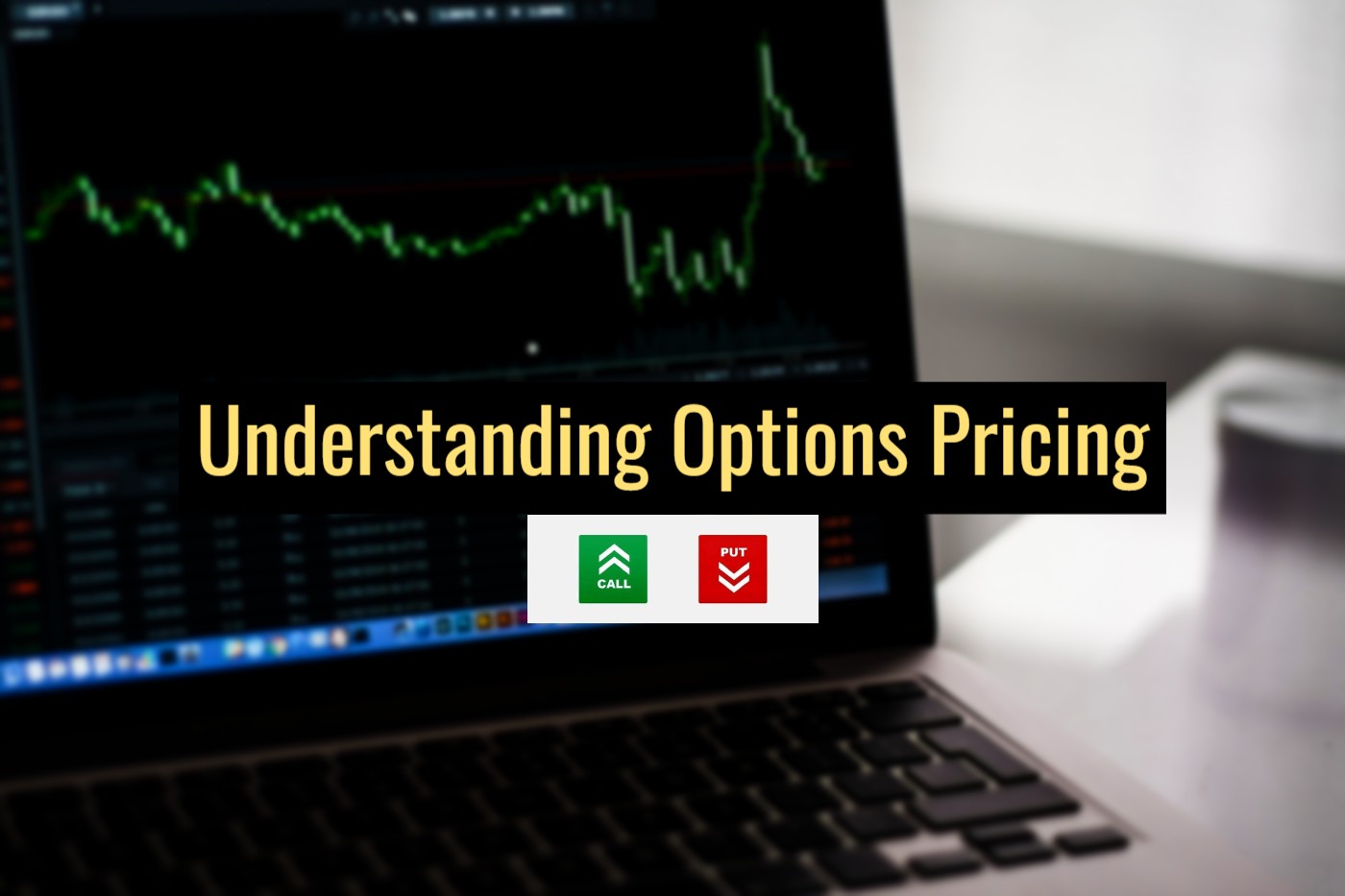
Before getting started with trading options, you should have a good understanding of options pricing and the various factors that play a role in establishing the value of an option. There are also several option pricing models that are used to identify the value of a call or a put option. A solid understanding of options pricing factors and models will help you take advantage of price movements and optimize your earnings from your investments.
Understanding option pricing (Option Premium Explained)
Option pricing is the amount per share you have to pay to trade an option. The price of an option is also known as the premium. The buyer of an option needs to pay the premium amount to the seller to earn the rights granted by the option. Option premiums are priced per share. Since options are available in lots of shares called lot size, you need to pay:
Total Premium Amount= (premium price per share) X (lot size)
For example, say TCS option with a strike price of Rs. 2,500 is available at a premium of Rs. 20 per share for a lot size of 100 shares. To buy the option, you need to pay a premium amount of Rs. 20 X 100 = Rs. 2,000. The premium paid is non-refundable whether you choose to exercise your option or not.
What are the main factors determining an Option’s Price or Premium?
There are many factors that influence the price of an option:
1. Value of the option’s underlying asset
As we know, options are derived from underlying instruments like shares, gold, currency etc. The current value or price of the option’s underlying instrument has a direct effect on the price of the call or put option. If the value of the underlying instrument is on the rise then the call option price will increase and put option price will decrease. If the price of the underlying instrument decreases then call option price will decrease and put option price will increase.
2. Intrinsic Value of an Option
Intrinsic value refers to the value of the option if it were exercised today. It is calculated as a difference between the price of the underlying instrument from which the option is derived and strike price. The strike price is the price at which a buyer and a seller decided to enter the contract.
For call options, intrinsic value is calculated as –
- Intrinsic Value = Spot Price – Strike Price
- For put options, intrinsic value is calculated as-
- Intrinsic Value = Strike Price – Spot Price
The intrinsic value of an instrument can only be positive and zero. It cannot be negative.
The intrinsic value of an option helps you in determining the profit advantage in case you wish to exercise the option immediately. It can be also called as the minimum value of an option.
3. Time Value of an Option
It is calculated as the difference between premium and intrinsic value.
Time Value = Premium-Intrinsic Value
The time value is directly related to how much time an option has until it expires. Generally, the longer the time for an option to expire, the higher is the premium. And it decreases as you come closer to the expiry date of the option.
4. Volatility
Volatility is the probability of the price fluctuation (up or down) of the underlying instrument in the market. The higher the volatility of the underlying instrument, the higher the premium. It is because highly volatile stocks have a higher possibility of bringing profits to investors in a short time.
Volatility is of two types – historical and implied. Historical volatility measures the fluctuations observed in an underlying instrument in the past. Implied volatility predicts the fluctuations in the future.
5. Interest Rates
Normally interest rates have nominal influence on options pricing. But it can be a factor if you are trading in options of large size. There is no direct effect of interest rates on options pricing. Its effect is related to the cost of funds. Let’s assume that to trade in a large options contract, you decide to borrow money from banks or use funds from your savings that are earning some interest rates. Whichever way you go, you are paying interest on the loan or losing interest in case of savings. So the cost of your funds now is invested amount plus the interest on it. If the interest rate is high then the cost of money invested is also high. So when interest rates are high, the premium falls and vice versa.
6. Dividends on underlying stocks
In the event of dividend announcements during the life of an option, the exchanges adjust the option positions. As per regulations by SEBI, if the value of the dividend is more than 10% of the spot price of the option on the date the dividend is announced, then the strike price of the options are reduced by the dividend amount on ex-dividend dates. For dividends announced lower than 10% of the spot price, there is no adjustment by the exchange. Dividend announcement decreases the value of the option as the stock value decreases on the ex-dividend date.
Effect of Market Factors on Call option price and Put option price
| Factors Affecting Option Premium | Effect on Call Option Price/Premium | Effect on Put Option Price/Premium |
| Increase in the value of the underlying instrument | Increase | Decrease |
| Increase in Intrinsic Value | Decrease | Increase |
| Increase in Time Value | Increase | Increase |
| Increase in Volatility | Increase | Increase |
| Increase in Interest rates | Increase | Decrease |
| Increase in Dividends | Decrease | Increase |
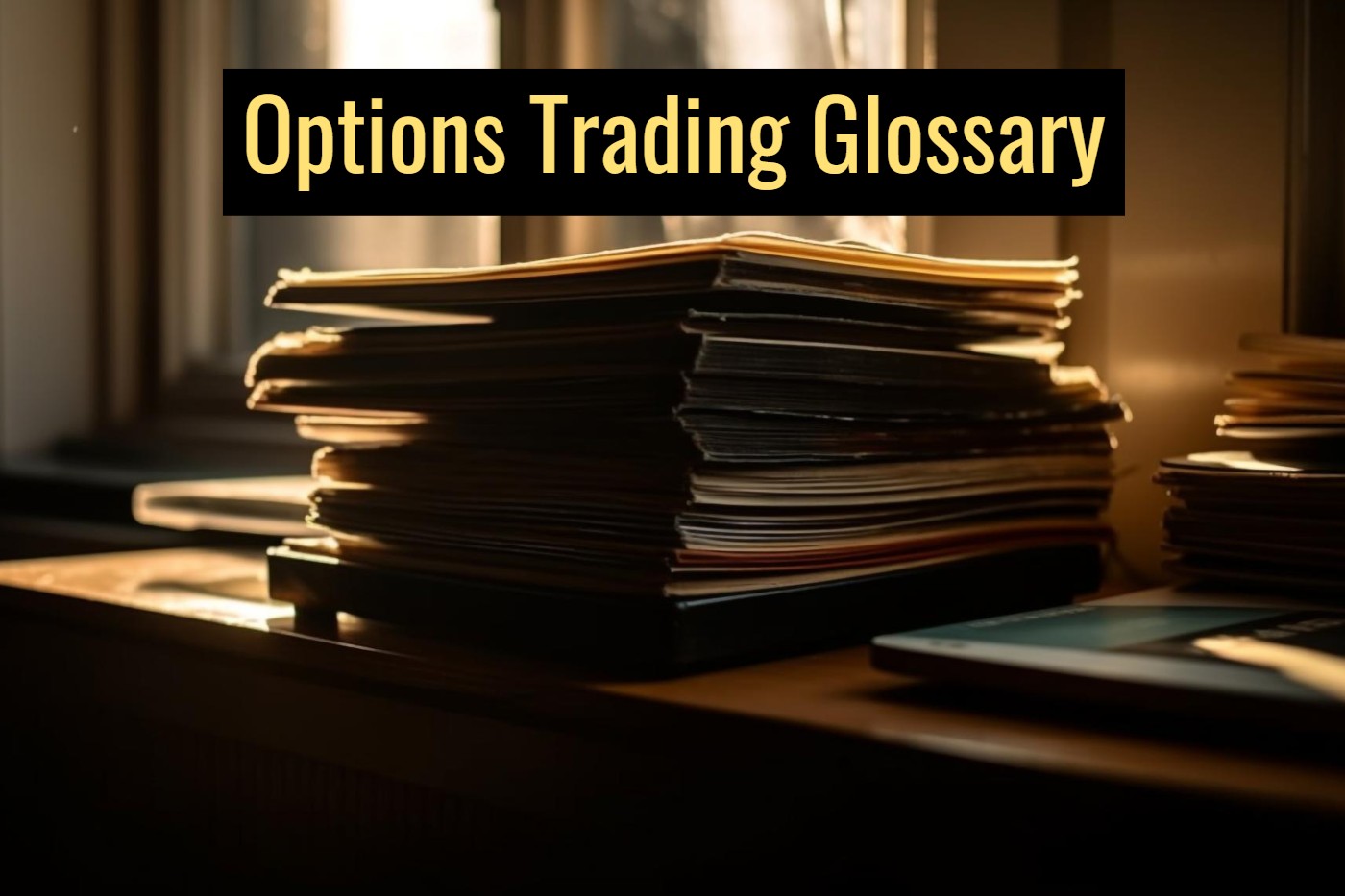
- Algo Trading: Algo trading refers to the utilization of software programs to engage in automated trading.
- American Option: American Options allow for the exercise of the option on any day within the expiration date.
- Assignment in Options: Assignment in Options refers to the ability to exercise an American Option on any day within the expiration date.
- At-the-money (ATM): When the price of an Option is equal to its strike price, it is considered to be at-the-money.
- Bear Call Spread: Bear Call Spread is a trading strategy involving the simultaneous buying and selling of Options with the same underlying asset and expiration date but different strike prices.
- Box Spread: Box Spread is an arbitrage strategy that utilizes Call and Put Options to achieve a riskless profit.
- Box Spread Strategy: Box Spread Strategy is an Option arbitrage strategy employed when the underlying asset is undervalued.
- Break-Even Point (BEP): Break-Even Point (BEP) is the price at which an Option contract neither yields a profit nor incurs a loss.
- Bull Call Spread: Bull Call Spread is a trading position that involves buying and selling Options with the same underlying asset and expiration date but different strike prices.
- Call Option: A Call Option is an Option contract that grants the buyer the right, but not the obligation, to purchase an underlying asset at a specified price within a specified period.
- Cloud Order: Cloud Order is a special feature offered by ICICI securities, enabling traders to create and save orders at any time for execution during market hours.
- Delta Option Greek: Delta measures the extent to which the price of an Option changes in relation to changes in the price of its underlying asset.
- European Option: European Options can only be exercised on the expiration date.
- Exercising Options: Exercising an Option refers to the act of a trader deciding to utilize the rights granted by an Option contract.
- Expiry: Expiry is the final date, typically the last Thursday of the month, on which an Option contract expires.
- Gamma Option Greek: Gamma measures the change in an Option’s Delta in response to changes in its underlying asset.
- In-the-money (ITM): When the price of an Option exceeds its strike price, it is considered to be in-the-money.
- Index Options: Index Options are Option contracts where the underlying asset is an index, such as Nifty 50 or Bank Nifty.
- Long Option: A Long option is a position in which a trader buys an Option.
- Long position: A Long position refers to the act of buying an Option.
- Lot Size: Lot size refers to the number of shares of the underlying asset in an Option contract.
- Mark-to-Market Settlement (MTM): Mark-to-Market Settlement, also known as MTM settlement, is the process of adjusting the profit or loss made on an open position of a derivatives contract on the same day.
- Moving averages: Moving averages are utilized to forecast the direction of a specific Option trend.
- Open Interest (OI): Open interest (OI) is a derivative indicator that represents the total number of unsettled derivative contracts, such as options or futures, at a given point in the market.
- Option Greeks: Option Greeks assist traders in determining the price change of an Option due to various factors.
- Option Market Participants: Participants in the Options market can be categorized into Hedgers, Speculators, and Arbitrageurs based on their risk appetite and trading approach.
- Option Tick Size: Option Tick Size is the minimum increment by which the price of an Option contract can change.
- Option Writer or Option writing: An Option Writer is an individual who sells or shorts an Option without holding the underlying asset of the Option.
- Options Arbitrage: Options Arbitrage is a strategy where a trader takes multiple positions to minimize the risk of their trade.
- Options Chart: Option chains, also known as Options Charts, are used by traders to perform technical analysis on the underlying stock of an Option.
- Options Contract: An Options Contract grants the buyer the right, but not the obligation, to sell an underlying asset at a specified price and on a specific date.
- Options Fair Market Value: Options Fair Market Value is the theoretical price of an Option calculated using Options pricing models.
- Options Hedging: Option contracts serve as useful tools for hedging.
- Options Market: An Options Market is a marketplace where traders buy and sell Options.
- Options Premium: The price paid by an Option buyer or received by an Option seller is referred to as the premium of an Option.
- Options Secondary Market: The Options Secondary Market is a market where previously issued Options on the NSE and BSE are traded.
- Options Spread: An Options Spread is created by taking two positions, buying and selling Options with the same underlying asset and expiration date.
- Options Trading App: An Options Trading App is a mobile application that enables traders to engage in Options trades from anywhere and at any time.
- Options Writer: An Options Writer is an individual who sells an Option, also known as the seller of the Option.
- Out-of-the-money (OTM): When the price of an Option has not reached its strike price, it is considered to be out-of-the-money.
- Over The Counter (OTC) Options: Options that are traded away from exchanges like NSE and BSE are referred to as Over The Counter (OTC) Options.
- Paired Option Contracts: Paired Option Contracts allow traders to take two different positions on the same Option in a single order.
- Post-market Trading Hours (Post Close Trading Session): The Post-market Trading Hours, also known as the Post Close Trading Session, is a session conducted between 3:40 PM and 4:00 PM for trading shares at a fixed predetermined price.
- Pre-Market Trading hours: The Pre-Market Trading Hours consist of two sessions, Order Entry and Order Matching, conducted between 9:00 AM and 9:15 AM.
- Put Option: A Put Option is an Option contract that grants the buyer the right, but not the obligation, to sell an underlying asset at a specified price within a specified period.
- Rho Option Greek: Rho measures the change in the price of an Option with every percentage change in interest rates.
- Short Option: A Short Option is a position in which a trader sells an Option.
- Spot Price: The current market price of the underlying asset of an Option is referred to as the Spot Price.
- Squaring Off an Option: Squaring Off an Option involves selling an Option of the same underlying asset, expiration date, and strike price that was previously bought.
- Strike price or exercise price: The Strike price, also known as the exercise price, is the specific price at which an Option is purchased, granting the buyer the right to exercise the Option.
- Synthetic position: A Synthetic position is created by combining different types of Options to create a single Option.
- Theta Option Greek: Theta measures the change in the price of an Option with each passing day towards its expiration.
- Time decay or erosion: Time decay, also known as erosion, refers to the decrease in the value of an Option as time passes.
- Uncovered call writing: Uncovered call writing refers to the act of selling a Call Option without holding the underlying asset.
- Vega Option Greek: Vega measures the impact of changes in the volatility of the underlying asset on the price of its Option.
- Vertical spread option strategy: A vertical spread option strategy is a two-legged strategy involving the buying and selling of Call and Put Options.
- Volatility: Volatility is the rate of change in the price of the underlying asset of an Option.
- Volume in Options: Volume in Options is an indicator of the level of trader interest in a particular Option.
Trending
-
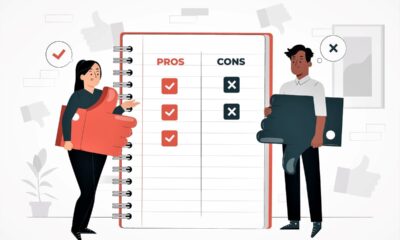
 Broker Reviews2 years ago
Broker Reviews2 years agoCompare Brokers
-

 Broker Reviews2 years ago
Broker Reviews2 years agoBest of Stock Brokers in India
-

 Authorised Person2 years ago
Authorised Person2 years agoAuthorised Person Registration
-

 Vastu Shastra8 months ago
Vastu Shastra8 months agoVastu Tips to Enhance the Success Ratio in Broking & Wealth Business
-

 Franchise2 years ago
Franchise2 years agoFranchise Offers
-
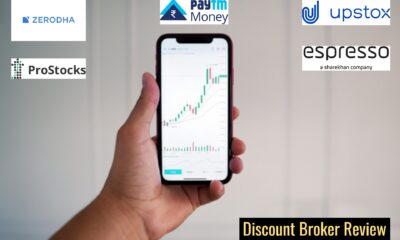
 Broker Reviews2 years ago
Broker Reviews2 years agoDiscount Broker Review
-

 Demat2 years ago
Demat2 years agoZerodha Demat Account
-

 Demat2 years ago
Demat2 years agoDemat




